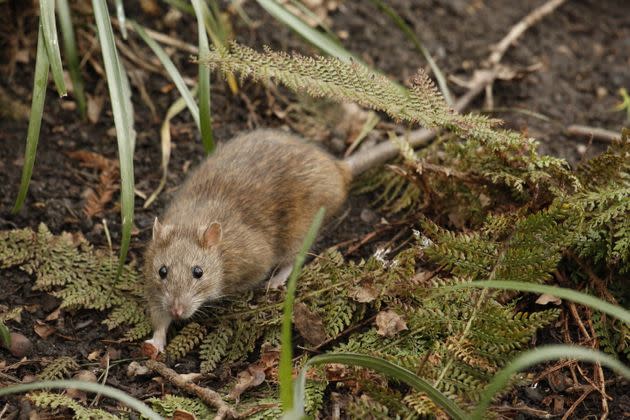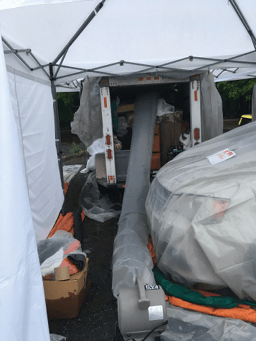cells
VeroE6/TMPRSS2 (JCRB 1819) cells29 were propagated in Dulbecco’s modified Eagle’s medium with 10% fetal calf serum in the presence of 1 mg ml−1 Geneticin (G418; Invivogen) and 5 μg ml−1 Plasmocin prophylactic (Invivogen). VeroE6-TMPRSS2-T2A-ACE2 cells (supplied by B. Graham, NIAID Vaccine Research Center) were grown in Dulbecco’s modified Eagle’s medium supplemented with 10% fetal calf serum, 10 mM HEPES pH 7.3, 100 U ml-1 penicillin -streptomycin, cultured and 10 µg ml -1 puromycin. VeroE6/TMPRSS2 and VeroE6-TMPRSS2-T2A-ACE2 cells were maintained at 37°C with 5% CO2. The cells were regularly tested for mycoplasma contamination by means of PCR and confirmed as mycoplasma-free.
viruses
hCoV-19/Japan/UT-NCD1288-2N/2022 (BA.2; NCD1288)4,30, hCoV-19/Japan/TY41-703/2022 (BA.4; TY41-703), hCoV-19/Japan /TY41-702/2022 (BA.5; TY41-702), hCoV-19/Japan/TY41-704/2022 (BA.5; TY41-704) and hCoV-19/USA/WI-UW-5250/2021 (B.1.617.2; UW5250)1,31 were grown in VeroE6/TMPRSS2 cells in VP-SFM (Thermo Fisher Scientific). hCoV-19/USA/MD/HP30386/2022 (BA.4; HP30386) and SARS-CoV-2/human/USA/COR-22-063113/2022 (BA.5; COR-22-063113) were increased VeroE6 – TMPRSS2-T2A-ACE2 cells in VP-SFM (Thermo Fisher Scientific). TY41-703 (BA.4), COR-22-063113 (BA.5) and TY41-704 (BA.5) were subjected to NGS (see whole genome sequencing); Amino acid differences between these viruses and the reference sequence (Wuhan/Hu-1/2019) are presented in Extended Data Table 1. All experiments on SARS-CoV-2 were performed in safety laboratories of increased biosafety level 3 at the University of Tokyo and National Institute of Infectious Diseases, Japan approved for such use by the Japanese Ministry of Agriculture, Forestry and Fisheries, or in agricultural containment laboratories Biosafety Level 3 at the University of Wisconsin, Madison, approved for such use by the Centers for Disease Control and Prevention and the US Department of Agriculture.
Animal testing and approvals
Animal testing was performed in accordance with recommendations in the National Institutes of Health’s Guide to the Care and Use of Laboratory Animals. The protocols were approved by the University of Tokyo Institute of Medical Science Animal Experiment Committee (Approval Number PA19-75) and the University of Wisconsin, Madison Institutional Animal Care and Use Committee (Assurance Number V006426). Virus inoculations were performed under isoflurane and every effort was made to minimize animal suffering. In vivo studies were not blinded and animals were randomly assigned to infection groups. No sample size calculations were performed to support each study. Instead, sample sizes were determined based on previous in vivo virus challenge experiments.
Experimental infection of Syrian hamsters
Six-week-old male Syrian wild-type hamsters (Japan SLC Inc.) were used in this study. Baseline body weights were measured prior to infection. Under isoflurane anesthesia, five hamsters per group were injected intranasally with 105 PFU (in 30 μl) BA.2 (NCD1288), BA.4 (HP30386 or TY41-703), BA.5 (COR-22-063113, TY41-702 or TY41-704) or B.1.617.2 (UW5250). Body weight was monitored daily for 10 days. For virological and pathological studies, ten hamsters per group were infected intranasally with 105 PFU (in 30 μl) BA.2 (NCD1288), BA.4 (HP30386), BA.5 (COR-22-063113) or B.1.617.2 (UW5250); At 3 and 6 dpi, five animals were sacrificed and turbinates and lungs collected. Virus titers in turbinates and lungs were determined by plaque assays on VeroE6-TMPRSS2-T2A-ACE2 cells.
The K18-hACE2 transgenic hamster lines (line M41) were developed using a PiggyBac-mediated transgenic approach. The K18-hACE2 cassette from the pK18-hACE2 plasmid was transferred into a PiggyBac vector, pmhyGENIE-332, for nuclear injection15. Then, 5 to 10-week-old K18-hACE2 homozygous transgenic hamsters, for which hACE2 expression was confirmed, were inoculated intranasally with 105 PFU (in 30 μl) of BA.2 (NCD1288) (sex: two males and two females) , BA.4 (HP30386) (Sex: one male and three females), BA.5 (COR-22-063113) (Sex: one male and three females) or B.1.617.2 (UW5250) (Sex: two males and two females). Body weight was monitored daily for 5 days. At 5 dpi, animals were sacrificed and turbinates and lungs collected. Virus titers in turbinates and lungs were determined by plaque assays on VeroE6-TMPRSS2-T2A-ACE2 cells.
For co-infection studies in wild-type hamsters, BA.2 (NCD1288) was mixed with BA.4 (HP30386) or BA.5 (COR-22-063113) in an equal ratio based on their titer, and the virus mixture (total 2nd x 10 5 PFU in 60 µl) was inoculated into ten wild-type hamsters. At 2 and 4 dpi, five animals were sacrificed and turbinates and lungs were collected. For co-infection studies in K18-hACE2 transgenic female hamsters, BA.2 (NCD1288) was mixed with BA.5 (COR-22-063113) at a 1:1 or 3:1 ratio based on their titer, and each virus mixture ( a total of 2 x 10 5 PFU in 60 µl) was inoculated into five K18-hACE2 transgenic hamsters. At 3 dpi, all five animals were sacrificed and turbinates and lungs were collected.
Experimental infection of K18-hACE2 mice
Ten week old female K18-hACE2 mice (Jackson Laboratory) were used in this study. Baseline body weights were measured prior to infection. Under isoflurane anesthesia, five mice per group were inoculated intranasally with 105 PFU (in 25 μl) of BA.2 (NCD1288), BA.4 (HP30386), BA.5 (COR-22-063113) or B.1.617.2 ( UW5250). Body weight was monitored daily for 10 days. For the virological study, five mice per group were injected intranasally with 105 PFU (in 25 μl) BA.2 (NCD1288), BA.4 (HP30386), BA.5 (COR-22-063113), BA.5 (TY41 -702) or B.1.617.2 (UW5250); At 2 and 5 dpi, five animals were sacrificed and the lungs collected. Lung virus titers were determined by plaque assays on VeroE6-TMPRSS2-T2A-ACE2 cells.
lung function
Respiratory parameters were measured using a whole-body plethysmography system (PrimeBioscience) according to the manufacturer’s instructions. Briefly, infected hamsters were placed in the unhindered plethysmography chambers and allowed to acclimate for 1 minute before collecting data over a 3 minute period using FinePointe software.
histopathology
Histopathological examination was performed as previously described1,4. Briefly, excised animal lungs were fixed in 4% paraformaldehyde in phosphate-buffered saline and processed for paraffin embedding. The paraffin blocks were cut into 3 µm thick sections and mounted on silane-coated glass slides, followed by hematoxylin and eosin staining for histopathological examination. Tissue sections were also processed for immunohistochemistry with a rabbit polyclonal antibody to SARS-CoV nucleocapsid protein (ProSpec; ANT-180, dilution 1:500, Rehovot, Israel) that cross-reacts with SARS-CoV-2 nucleocapsid protein. Specific antigen-antibody reactions were visualized by staining with 3,3′-diaminobenzidine tetrahydrochloride and using the Dako Envision system (Dako Cytomation; K4001, 1:1 dilution, Glostrup, Denmark). For the detection of SARS-CoV-2 RNA, in situ hybridization was performed using an RNA Scope 2.5 HD Red Detection Kit (Advanced Cell Diagnostics, Newark, California) with an antisense probe that to the nucleocapsid gene of SARS-CoV-2 (Advanced Cell Diagnose) and according to the manufacturer’s instructions.
Histopathologic scores of inflammation in the alveolar regions were determined based on the percentage of alveolar inflammation in a given area of a lung section collected from each animal in each group using the following scoring system: 0, no inflammation; 1, affected area (≤1%); 2, affected area (>1%, ≤10%); 3, affected area (> 10%, ≤ 50%); 4, affected area (> 50%). An additional point was added if pulmonary edema and/or alveolar hemorrhage was observed. Therefore, the histopathological scores of inflammation in the alveoli for individual animals ranged from 0 to 5. The immunohistochemical scores were determined based on the percentage of viral antigen-positive cells detected by immunohistochemistry in a high power field using the following scoring system: 0, no positive cells; 1, positive cells (≤10%); 2, positive cells (>10%, ≤25%); 3, positive cells (>25%, ≤50%); 4, positive cells (>50%). The immunohistochemical scores for each animal were calculated for the bronchial/bronchiolar and alveolar regions, respectively, as the overall score for the three high-power fields with the highest positivity rate on the section; scores for individual animals ranged from 0 to 12.
whole genome sequencing
Viral RNA was extracted using a QIAamp Viral RNA Mini Kit (QIAGEN). The entire SARS-CoV-2 genome was amplified using a modified ARTIC network protocol, replacing or adding some primers33,34. Briefly, viral complementary deoxoribonucleic acid was synthesized from the extracted RNA using a LunarScript RT SuperMix Kit (New England BioLabs). The DNA was then amplified by performing multiplex PCR in two pools using ARTIC-N5 primers35 and Q5 hot start DNA polymerase (New England BioLabs). Illumina NGS DNA libraries were prepared from pooled amplicons using a QIAseq FX DNA Library Kit (QIAGEN) and then analyzed using the iSeq 100 System (Illumina). To determine the sequence of TY41-703 (BA.4), COR-22-063113 (BA.5) and TY41-704 (BA.5), the reads from the CLC Genomics Workbench (v.22, Qiagen) were compiled. with the Wuhan/Hu-1/2019 sequence (GenBank Accession No. MN908947) as reference. The sequences of TY41-703 (BA.4), COR-22-063113 (BA.5) and TY41-704 (BA.5) have been deposited with Genbank under accession IDs OP603964, OP603961 and OP603965, respectively. For the analysis of the ratio of BA.2 to BA.4 or BA.5 after co-infection, the ratio of BA.2 to BA.4 or BA.5 was calculated from the 5 amino acid differences in the S gene between the two viruses. Samples with more than 300 reading depths were analyzed.
Statistical analysis
GraphPad Prism software was used to analyze all data. Statistical analysis included the Kruskal-Wallis test followed by Dunn’s test and ANOVA with post hoc tests. Differences between groups were considered significant for P values less than 0.05.
Summary of Reporting
For more information on the research design, see the Nature Portfolio Reporting Summary linked to this article.


/cloudfront-us-east-1.images.arcpublishing.com/gray/XEJMC7PTY5G3RPB4XX5AUY6Q3I.jpg)







